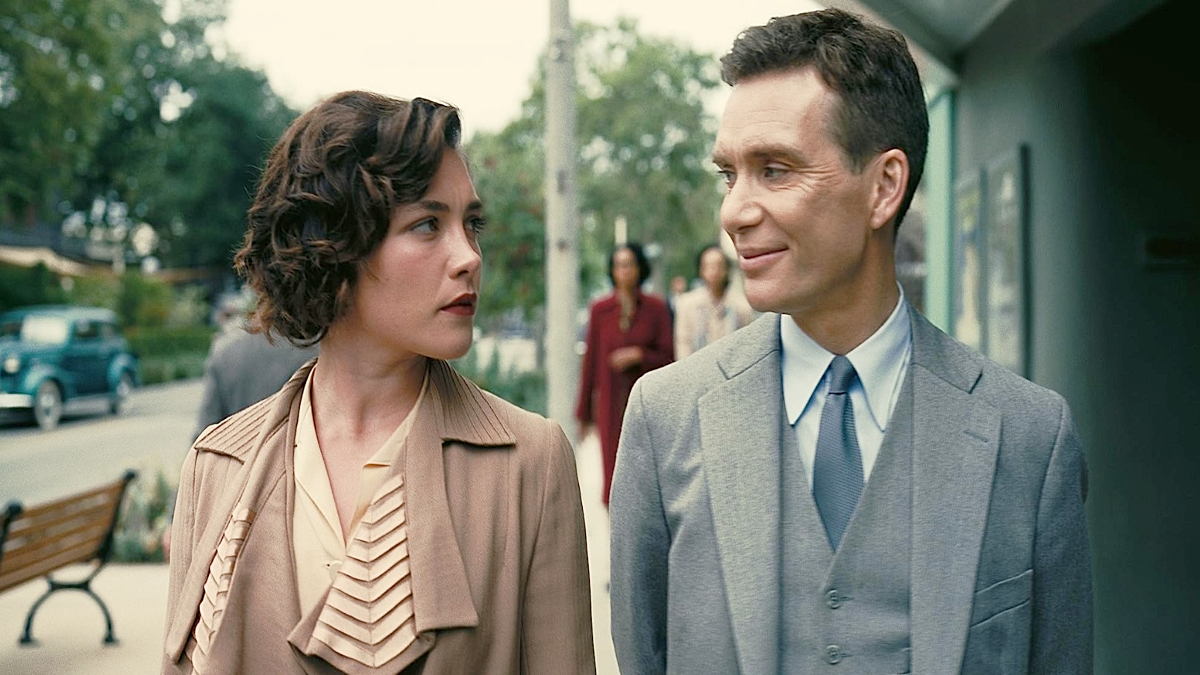Warning: The following article contains spoilers for Oppenheimer.
There’s a lot to unpack in Christopher Nolan’s Oppenheimer. The film considers at least three different timelines depicted across three dense hours of theoretical physics lessons, political machinations, interrogations, and at least two crucial romances in the life of J. Robert Oppenheimer, father of the atomic bomb. The latter holds a mystery never solved by the filmmaker or its source material — the biography American Prometheus by Kai Bird and Martin J. Sherwin. Specifically, what really happened to Jean Tatlock (Florence Pugh)?
Tatlock was an American psychiatrist and physician who had an on-again, off-again romance with Oppenheimer even after he married biologist Katherine Puening (Emily Blunt). Tatlock was also a member of the Communist Party of the United States of America and served as a writer for the party’s publication Western Worker.
Although the film deals openly with Tatlock’s struggle with depression and names her death in 1944 as a suicide on numerous occasions, Nolan adds brief shots of gloved hands managing the body that suggest the potential for foul play in her demise.
Viewers hoping for a clear answer never get one, as Oppenheimer’s ambivalence over his signature act of creation takes most of the spotlight in the film’s second half.
Was Jean Tatlock murdered?
Obviously, if Nolan didn’t suggest a conclusion, we’re meant to be left wondering. But history holds some clues.
According to American Prometheus, Jean’s father found her body on Jan. 5, 1944. After getting no response to ringing the doorbell, he allegedly climbed in through a window. Per other accounts, including the blog of nuclear weapons historian Alex Wellerstein, her father found Jean situated on cushions in the bathroom with her head submerged in bathwater.
Sources say she left a suicide note that read:
“I am disgusted with everything. … To those who loved me and helped me, all love and courage. I wanted to live and to give and I got paralyzed somehow. I tried like hell to understand and couldn’t. … I think I would have been a liability all my life — at least I could take away the burden of a paralyzed soul from a fighting world.”
According to An Atomic Love Story: The Extraordinary Women in Robert Oppenheimer’s Life by Shirley Streshinsky and Patricia Klaus, Tatlock was under surveillance by the FBI at the time of her death, likely due to her communist activities and relationship with Oppenheimer while he headed the Manhattan Project. Because of this, FBI director J. Edgar Hoover was one of the first people notified of her death.
American Prometheus noted that a formal inquest in February 1944 offered a verdict of “Suicide, motive unknown” in Tatlock’s death. The report found that Tatlock had taken some barbituates, but not a fatal dose. The assessment also found traces of chloral hydrate, despite no alcohol being found in her blood. However, as a working psychiatrist, she had access to sedatives like chloral hydrate. The cause of death was listed as “acute edema of the lungs with pulmonary congestion,” meaning she likely knelt over the bathtub, took chloral hydrate, and submerged her head in the water until death.
However, considering the U.S. government’s distrust of Tatlock, some historians and members of Jean’s own family have suggested that her death may not have been a suicide. There’s a popular conspiracy theory that she was murdered by intelligence agents working for the Manhattan Project, which seems to square with broad findings unrelated to Tatlock that were delivered by the Church Committee, a U.S. Senate select committee that investigated abuses by the CIA, FBI, IRS, and the National Security Agency (NSA) around that time. American Prometheus included a quote from a physician who studied Tatlock’s death and said, “If you were clever and wanted to kill someone, this is the way to do it.”
What does Nolan think? Like everyone else who has considered Talock’s death, he seems to be open to both interpretations. Is the figure who is glimpsed in the room with Jean’s body her father? Perhaps a police or government official studying the scene? Or is it someone arranging her body to look like a suicide, hence removing her influence from the life of Oppenheimer as he built the atomic bomb?
Nolan’s assumption here seems to be that Oppenheimer himself may have always wondered what really happened. And so the audience is left with doubts as well, swirling madly like a forming mushroom cloud.

